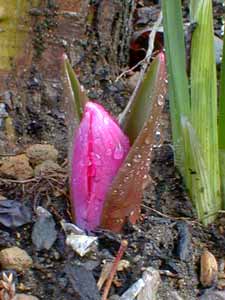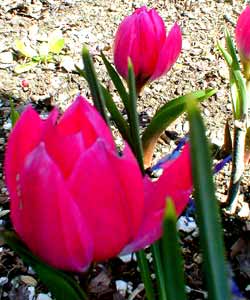 "Violacea"
"Violacea"
Crocus Tulip, Strain #1
"The tulips now are pushing up
Like small green knuckles through the ground.
The grass is young & doubtful yet,
The robin takes a look around."
--Eunice Tietjens
(1894-1944)
(1894-1944)
'Violacea' is a naturally occuring variant of T. humilis, this variant having been discovered in Kurdistan. It is a dwarf botanical, called a crocus-tulip because of its ultra-short stature & early bloom.
'Violacea' from different bulb producers have an unusually broad variation in habit & appearance, though few of the varied clones have been given individual names. The one shown on this page we have designed 'Violacea #1' but we have a another that is very different from another grower, so we've given it a separate page as 'Violacea #2.' We have a third clone of 'Violacea' which is again quite different in bloom-time, size, & appearance, but that one has been blessed with its own name, 'Persian Pearl.'
'Violacea #1' grows along a rockery ledge in full morning sun near the base of a hawthorn tree & alongside dwarf reticulated irises.It is four or at most five inches tall, which despite such smallness is nevertheless a bit bigger than 'Violacea #2.' It's fat bright electric fuchsia-pink buds are showy by mid-February, as shown in the first photo. These buds became bigger & bigger but remain globe-shaped & never really opened all the way, as shown in the second photo from early March. 'Violacea #2' does not bloom quite this early, but it produces its leaves first; when the leaves of 'Violacea #1' emerge, the already-pink bud pokes out of the ground at the same time.
 The ones under the hawthorn tree ought to naturalize in such a sunny location, where the sun hits them not only during blooming weeks when deciduous limbs above are bare, but the spot remains morning-sunny even when the deciduous trees & shrubs are releafed, when 'Violacea' flowers are spent & all that remains are tulip leaves recharging the bulbs.
The ones under the hawthorn tree ought to naturalize in such a sunny location, where the sun hits them not only during blooming weeks when deciduous limbs above are bare, but the spot remains morning-sunny even when the deciduous trees & shrubs are releafed, when 'Violacea' flowers are spent & all that remains are tulip leaves recharging the bulbs.This strain blooms so early that it even gets ahead of what had formerly been the first tulips to appear in our gardens, the kaufmannianas. That one pokes its leaves out of the ground by late January, but its blooms do not arrive until the first week of March, flowering simultaneously with the which get well ahead of the main tulip season.
'Violacea #1' waits an extra two weeks to show its leaves at mid-February compared to 'Violacea #2' which shows its first leaves at the very end of January but waits longer to produce buds. Because flower buds on #1 appear simultaneously with the leaves, it ends up blooming two weeks earlier than the earliest kaufmannianas, rendering this little tulip much more part of the crocus season.
I will continue to watch for additional 'Violacea' strains so I can add more bulbs each autumn. Not all of them bloom quite this early ('Persian Pearl' waits until March's end or the beginning of April), the possibility of lighting on other strains that will appear as early as February is to exciting not to keep adding others sold as 'Violacea,' if they seem to have originated with another bulb producer.